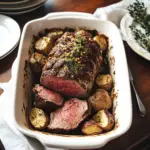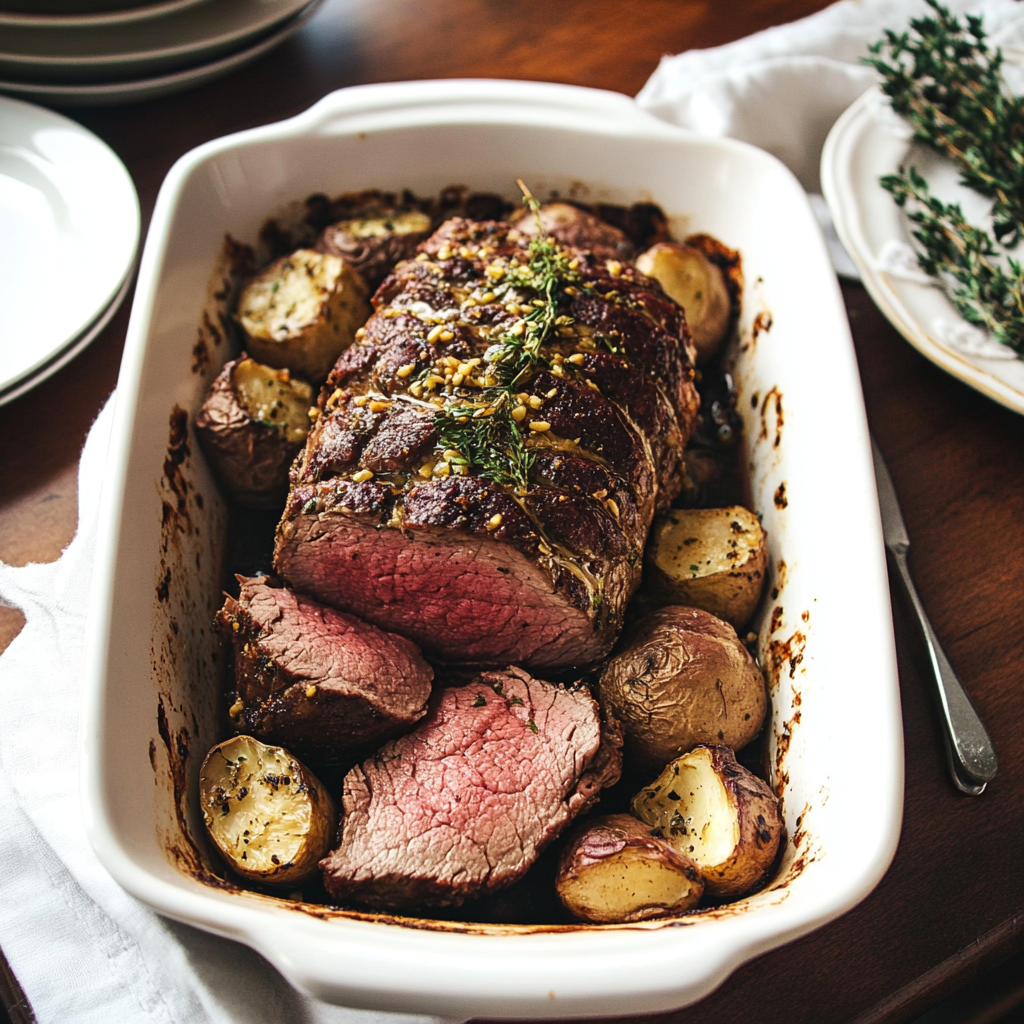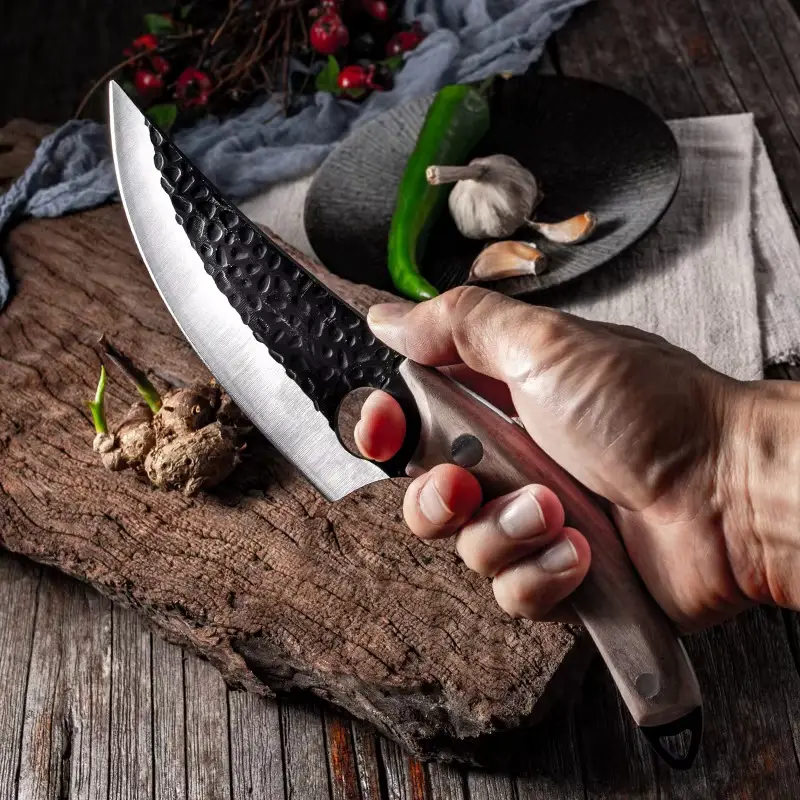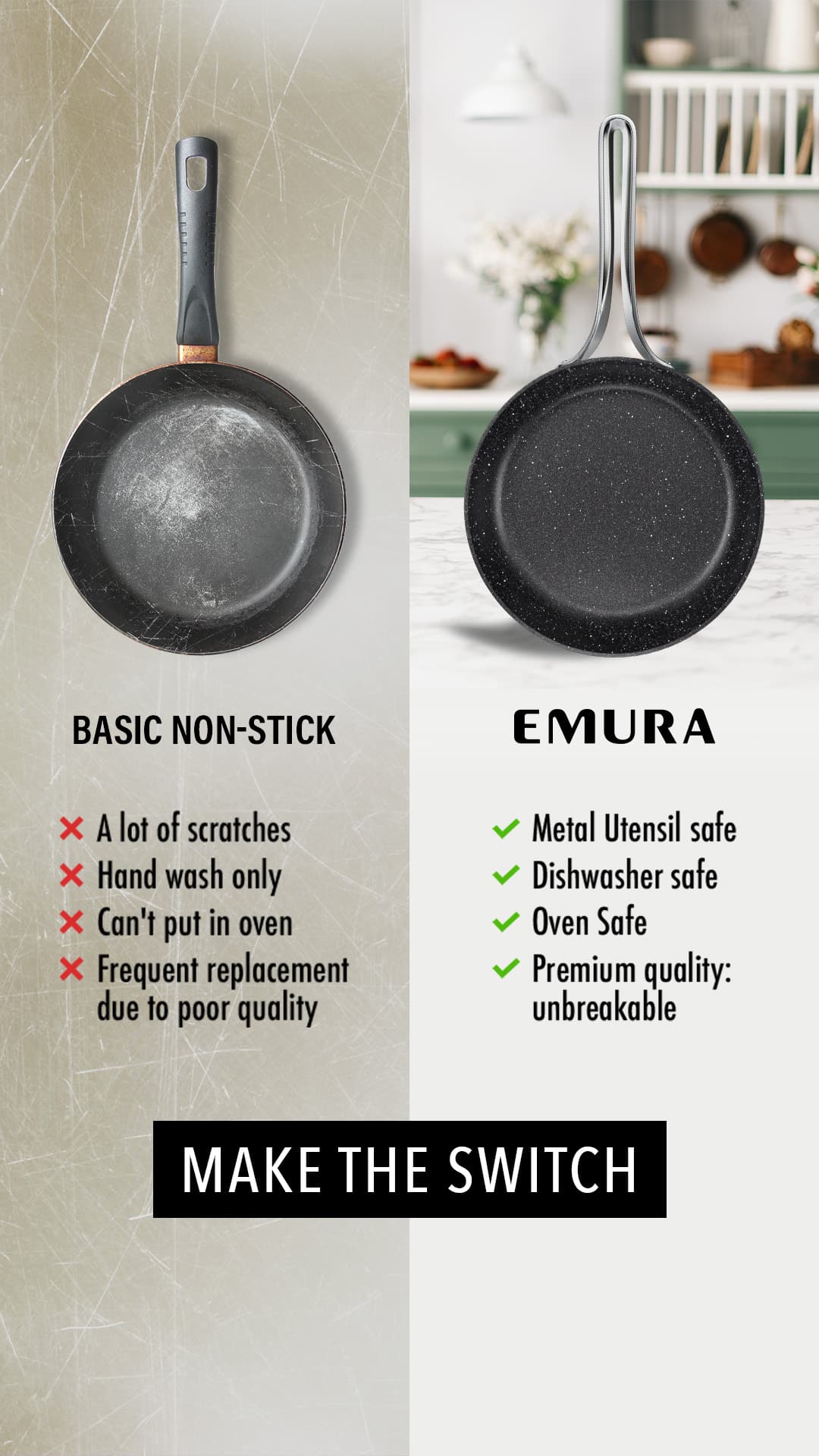Beef Tenderloin Roast is the epitome of elegance and indulgence, making it the perfect centerpiece for special occasions, holidays, or celebratory dinners. Renowned for its buttery tenderness and rich flavor, this cut of beef is one of the most prized in the culinary world. Whether you’re hosting a formal dinner party or preparing an unforgettable family feast, a perfectly cooked Beef Tenderloin Roast is guaranteed to impress.
This recipe strikes the ideal balance between simplicity and sophistication. The tenderloin is coated in a flavorful herb and garlic rub, seared to golden perfection, and then roasted to your desired doneness. Finished with a luscious pan sauce or served alongside a classic accompaniment like horseradish cream or red wine reduction, this dish delivers gourmet results with surprisingly little effort.
While the tenderloin itself is luxurious, its preparation is surprisingly straightforward. With proper seasoning, the right cooking techniques, and a focus on precision, even novice cooks can achieve restaurant-quality results. This guide will take you through each step, from selecting the best cut of beef to achieving the perfect medium-rare doneness, ensuring your Beef Tenderloin Roast is a showstopper at your next gathering.
Why You’ll Love This Recipe
- Melt-in-Your-Mouth Texture: Beef tenderloin is the most tender cut of beef, offering a luxurious dining experience.
- Impressive Presentation: A beautifully roasted tenderloin is a visual masterpiece, ideal for special occasions.
- Customizable Flavors: While simple herbs and garlic shine in this recipe, you can adapt the seasoning or sauces to suit your tastes.
- Minimal Ingredients, Maximum Impact: With just a handful of ingredients, this dish allows the beef’s natural flavor to shine.
- Perfect for Entertaining: This dish is easy to prepare ahead of time, giving you more time to enjoy your guests.
Preparation Time and Yield
- Prep time: 20 minutes
- Cook time: 35-45 minutes (depending on doneness)
- Resting time: 15 minutes
- Total time: 1 hour 20 minutes
- Yield: 6-8 servings
- Serving Size: Approximately 6 ounces per person
Nutritional Information (per serving)
- Calories: 340
- Carbohydrates: 1g
- Protein: 31g
- Fat: 23g
- Fiber: 0g
- Sugar: 0g
Ingredients
- 1 whole beef tenderloin, 3-4 pounds, trimmed of silver skin
- 3 tablespoons olive oil, divided
- 4 cloves garlic, minced
- 2 teaspoons kosher salt
- 1 teaspoon black pepper
- 2 teaspoons fresh rosemary, finely chopped
- 2 teaspoons fresh thyme, finely chopped
- 1 teaspoon Dijon mustard (optional)
Optional Pan Sauce
- 1 cup beef stock
- 1/2 cup red wine
- 2 tablespoons unsalted butter
- 1 teaspoon flour or cornstarch (for thickening, optional)
Step-by-Step Instructions
Step 1: Prepare the Beef Tenderloin
- Preheat your oven to 425°F (220°C) and allow the tenderloin to come to room temperature for about 30 minutes. This ensures even cooking.
- Trim any excess fat or silver skin from the tenderloin if it hasn’t already been done. Use kitchen twine to tie the tenderloin at 2-inch intervals to create a uniform shape, ensuring even cooking.
Step 2: Season the Tenderloin
- In a small bowl, mix the minced garlic, salt, pepper, rosemary, thyme, and 2 tablespoons of olive oil. If using Dijon mustard, mix it into the herb rub for an extra layer of flavor.
- Rub the mixture evenly over the entire surface of the beef tenderloin, pressing it gently to adhere.
Step 3: Sear the Tenderloin
- Heat the remaining tablespoon of olive oil in a large oven-safe skillet or roasting pan over medium-high heat.
- Sear the tenderloin on all sides until it develops a golden-brown crust, about 2 minutes per side. This step locks in flavor and enhances the texture.
Step 4: Roast the Tenderloin
- Transfer the skillet or pan to the preheated oven. Roast the tenderloin until it reaches your desired internal temperature:
- Rare: 120-125°F
- Medium-Rare: 130-135°F
- Medium: 140-145°F
Use an instant-read thermometer inserted into the thickest part of the meat for accuracy.
- Depending on the size of the tenderloin, roasting typically takes 25-35 minutes for medium-rare.
Step 5: Rest the Meat
- Remove the tenderloin from the oven and transfer it to a cutting board. Tent loosely with foil and let it rest for at least 15 minutes. Resting allows the juices to redistribute, ensuring tender and juicy slices.
Step 6: Make the Pan Sauce (Optional)
- While the tenderloin rests, prepare the pan sauce. Place the skillet with drippings over medium heat. Add the red wine, scraping up any browned bits from the bottom of the pan.
- Stir in the beef stock and simmer until the liquid reduces by half, about 5 minutes. For a thicker sauce, whisk in a teaspoon of flour or cornstarch.
- Finish by whisking in the butter until melted and glossy. Serve the sauce alongside the tenderloin.
Ingredient Background
- Beef Tenderloin: This cut comes from the loin of the cow and is prized for its tenderness and mild flavor. It’s the same cut used for filet mignon.
- Fresh Herbs: Rosemary and thyme are classic pairings with beef, offering earthy, aromatic notes that enhance the roast’s natural flavor.
- Garlic: Adds depth and savory richness, complementing the beef’s richness.
- Red Wine: If making the pan sauce, a dry red wine like Cabernet Sauvignon or Merlot adds acidity and depth of flavor.
Technique Tips
- Tie the Tenderloin: Tying the beef ensures it maintains its shape during cooking, resulting in even slices.
- Don’t Skip the Sear: Searing creates a caramelized crust that locks in juices and adds complexity to the flavor.
- Use a Meat Thermometer: Tenderloin can go from perfectly cooked to overdone quickly, so use an instant-read thermometer for accuracy.
- Resting Is Crucial: Resting allows the juices to redistribute, preventing them from spilling out when slicing.
To prevent overcooking, remove the tenderloin from the oven when it’s 5°F below your target temperature. It will continue to cook as it rests, reaching the perfect doneness.
Alternative Presentation Ideas
- Individual Steaks: Instead of roasting the whole tenderloin, cut it into 1 1/2-inch steaks (filet mignon) and pan-sear or grill each piece individually.
- Stuffed Tenderloin: Butterfly the tenderloin and fill it with a mixture of spinach, mushrooms, and cheese before rolling and roasting.
- Cedar Plank Roast: Cook the tenderloin on a soaked cedar plank for a smoky flavor and stunning presentation.
For an upscale dinner, serve the roast on a wooden carving board with rosemary sprigs and garlic cloves as garnish. A side of roasted vegetables and creamy mashed potatoes completes the look.
Additional Tips for Success
- Select the Right Cut: Ask your butcher for a trimmed tenderloin (Peeled Extreme) to save prep time.
- Room Temperature Beef: Allow the meat to rest at room temperature before cooking for even results.
- Avoid Over-Seasoning: Let the natural flavor of the tenderloin shine through by keeping the seasoning simple.
For a more luxurious finish, brush the roast with melted butter or drizzle truffle oil over the slices before serving.
Recipe Variations
- Pepper-Crusted Tenderloin: Coat the tenderloin in cracked black peppercorns before searing for a bold, peppery crust.
- Herb-Crusted Roast: Add breadcrumbs to the herb rub for a crispy, flavorful crust.
- Bacon-Wrapped Tenderloin: Wrap the tenderloin in strips of bacon before roasting for added richness.
Experiment with sauces, such as creamy horseradish, chimichurri, or Béarnaise, to complement the beef’s flavor.
Freezing and Storage
- Refrigeration: Store leftovers in an airtight container in the refrigerator for up to 3 days.
- Freezing: Freeze slices of tenderloin in a freezer-safe container for up to 3 months. Thaw in the refrigerator before reheating.
- Reheating: Warm slices in a low oven (275°F) with a splash of beef stock to prevent drying out.
To keep the tenderloin fresh and juicy, avoid reheating in the microwave, as it can overcook the meat.
Healthier Twist Ideas
- Use Leaner Cuts: Substitute tenderloin with sirloin for a leaner option.
- Reduce Fat: Use olive oil spray instead of drizzling oil for the rub.
- Skip the Sauce: The tenderloin is flavorful enough to stand alone without additional calories from sauce.
For a healthier side, pair the tenderloin with roasted Brussels sprouts, steamed asparagus, or a fresh green salad.
Serving Suggestions for Events
- Holiday Centerpiece: Serve alongside mashed potatoes, roasted vegetables, and a rich red wine for a holiday feast.
- Buffet-Style Dinner: Slice the tenderloin thinly and serve with rolls, horseradish cream, and arugula for make-your-own sandwiches.
- Romantic Dinner: Pair the roast with a silky potato gratin and sautéed green beans for an elegant meal for two.
To wow your guests, carve the roast tableside and serve with a glass of full-bodied red wine, such as Bordeaux or Malbec.
Special Equipment
- Meat Thermometer: Ensures precise cooking and prevents overcooking.
- Roasting Pan or Oven-Safe Skillet: For seamless transfer from stovetop to oven.
- Kitchen Twine: Helps maintain the tenderloin’s shape during cooking.
Frequently Asked Questions
1. What’s the difference between filet mignon and tenderloin?
Filet mignon is a specific cut from the tenderloin. The tenderloin is the entire muscle, while filet mignon refers to individual steaks cut from it.
2. Can I prepare the tenderloin ahead of time?
Yes! You can season the tenderloin up to 24 hours in advance and store it in the refrigerator. Let it come to room temperature before cooking.
3. Can I cook the tenderloin without searing?
While you can skip the sear, it’s highly recommended for a flavorful crust and even cooking.
4. What’s the best way to slice the roast?
Use a sharp carving knife and slice against the grain into 1/2-inch-thick slices for the most tender results.
5. How do I avoid overcooking the beef?
Use a meat thermometer and remove the tenderloin from the oven 5°F below your target temperature.
6. Can I cook this on the grill?
Yes! Sear the tenderloin over direct heat, then move it to indirect heat and grill until your desired doneness.
7. What if I don’t have fresh herbs?
Substitute with 1 teaspoon each of dried rosemary and thyme. Dried herbs are more concentrated, so use them sparingly.
8. Can I use a smaller tenderloin?
Absolutely! Adjust the roasting time based on the weight of the tenderloin.
Conclusion
Beef Tenderloin Roast is a dish that never fails to impress. Its melt-in-your-mouth texture, robust flavor, and elegant presentation make it the ideal choice for holidays, celebrations, or romantic dinners. With this detailed guide, you’ll master the art of roasting tenderloin, creating a meal that rivals any fine dining experience. Serve this showstopping roast at your next gathering, and watch your guests savor every bite.
Print
Beef Tenderloin Roast
- Total Time: 1 hour 20 minutes
- Yield: 6-8 servings 1x
Ingredients
- 1 whole beef tenderloin, 3-4 pounds, trimmed of silver skin
- 3 tablespoons olive oil, divided
- 4 cloves garlic, minced
- 2 teaspoons kosher salt
- 1 teaspoon black pepper
- 2 teaspoons fresh rosemary, finely chopped
- 2 teaspoons fresh thyme, finely chopped
- 1 teaspoon Dijon mustard (optional)
Optional Pan Sauce
- 1 cup beef stock
- 1/2 cup red wine
- 2 tablespoons unsalted butter
- 1 teaspoon flour or cornstarch (for thickening, optional)
Instructions
Step 1: Prepare the Beef Tenderloin
- Preheat your oven to 425°F (220°C) and allow the tenderloin to come to room temperature for about 30 minutes. This ensures even cooking.
- Trim any excess fat or silver skin from the tenderloin if it hasn’t already been done. Use kitchen twine to tie the tenderloin at 2-inch intervals to create a uniform shape, ensuring even cooking.
Step 2: Season the Tenderloin
- In a small bowl, mix the minced garlic, salt, pepper, rosemary, thyme, and 2 tablespoons of olive oil. If using Dijon mustard, mix it into the herb rub for an extra layer of flavor.
- Rub the mixture evenly over the entire surface of the beef tenderloin, pressing it gently to adhere.
Step 3: Sear the Tenderloin
- Heat the remaining tablespoon of olive oil in a large oven-safe skillet or roasting pan over medium-high heat.
- Sear the tenderloin on all sides until it develops a golden-brown crust, about 2 minutes per side. This step locks in flavor and enhances the texture.
Step 4: Roast the Tenderloin
- Transfer the skillet or pan to the preheated oven. Roast the tenderloin until it reaches your desired internal temperature:
- Rare: 120-125°F
- Medium-Rare: 130-135°F
- Medium: 140-145°F
Use an instant-read thermometer inserted into the thickest part of the meat for accuracy.
- Depending on the size of the tenderloin, roasting typically takes 25-35 minutes for medium-rare.
Step 5: Rest the Meat
- Remove the tenderloin from the oven and transfer it to a cutting board. Tent loosely with foil and let it rest for at least 15 minutes. Resting allows the juices to redistribute, ensuring tender and juicy slices.
Step 6: Make the Pan Sauce (Optional)
- While the tenderloin rests, prepare the pan sauce. Place the skillet with drippings over medium heat. Add the red wine, scraping up any browned bits from the bottom of the pan.
- Stir in the beef stock and simmer until the liquid reduces by half, about 5 minutes. For a thicker sauce, whisk in a teaspoon of flour or cornstarch.
- Finish by whisking in the butter until melted and glossy. Serve the sauce alongside the tenderloin.
- Prep Time: 20 minutes
- Cook Time: 35-45 minutes (depending on doneness) + Resting time: 15 minutes
Nutrition
- Serving Size: Approximately 6 ounces per person
- Calories: 340 kcal
- Sugar: 0g
- Fat: 23g
- Carbohydrates: 1g
- Fiber: 0g
- Protein: 31g



